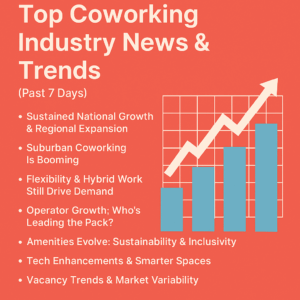As the coworking and flex office industry enters the final quarter of 2025, workspace operators are navigating a landscape marked by rapid evolution, strategic shifts, and bold innovation. Whether you manage a neighborhood coworking hub or oversee a portfolio of hybrid spaces, staying ahead means tracking the latest global trends, market data, and industry headlines.
This curated roundup brings together the most important coworking news stories from around the world over the past month. Dive in to discover the shifting strategies behind major growth, consolidations, technology adoption, sustainability initiatives, and corporate leasing trends. Each highlight is designed to help you make informed decisions, spot opportunities, and lead your team into the future of work—powered by actionable insights you won’t find anywhere else.
U.S. Coworking Footprint: It’s Getting Local…and Larger
After explosive growth in early 2025, U.S. operators are now consolidating, focusing on bigger, amenity-packed spaces in top-tier cities while rapidly scaling footprints in secondary suburbs and emerging tech markets. Manhattan saw its coworking locations shrink, but average facility size grew, as the sector pivots to fewer, higher-quality venues. Meanwhile, cities like Birmingham, Long Island, and West Palm Beach posted big gains as remote professionals shun lengthy commutes for vibrant neighborhood hubs. For full data on these trends, read the latest Q2 2025 U.S. Coworking Industry Report.
Consolidation: The New Normal for Operators
With market maturity comes strategic consolidation. Smaller operators are being acquired or dropping out, while industry giants like Regus, HQ, Industrious, and WeWork are expanding select locations and targeting portfolio optimization over raw expansion. Regus added 68 locations nationwide, and HQ saw double-digit percent growth in midsize cities. Get the details on the top operators in the CoworkingCafe Report.
Price Trends: Suburbs Catch Up to Urban
Prime metros such as Manhattan and Brooklyn still lead membership pricing, but suburban areas (especially those offering commuter convenience) are now commanding high rates for premium remote-first business addresses. Suburban virtual offices and day-pass rates have surged; for granular market-by-market pricing, see CoworkingCafe’s breakdown here.
India Steals the Show: Flex Market World Leader
India overtook all global competitors with a record-shattering 80M square feet of flexible workspace. The country’s market is fueled by international enterprise demand and innovative leasing structures—and is set to cross 100M feet in 2026. For global flex market rankings, check out Cushman & Wakefield’s summary of India’s dominance here.
Strategic Acquisitions Highlight Growth Forecast
This September, CBRE and Yardi made high-profile acquisitions in the flexible workspace sector, signaling confidence in long-term market growth and an accelerating shift toward industry-wide consolidation. Read the details in Orega’s market update here.
Enterprises Lean In: Branded Corporate Suites
Branded suites within coworking hubs are now the go-to solution for enterprise flexibility. Large companies favor these arrangements for agility, community, and scalable leases—even as hybrid models solidify. Operators working to appeal to enterprise clients must prioritize branding and design. For latest corporate coworking trends, see OfficeRnD’s global analysis here.
Automation and AI: Efficiency and Member Engagement
Coworking operators are embracing technology—specifically AI and automation—for space management, usage analytics, and tailored member experiences. Dynamic pricing and loyalty incentives are commonly used to maximize occupancy, especially on typically slow days. Learn how platforms like OfficeRnD Flex are driving this shift here.
Sustainability: A Key Differentiator
Green building certifications, sustainable fit-outs, and upcycled furnishings are now essential for attracting eco-conscious tenants and companies. Spaces are actively pursuing new sustainability strategies to remain competitive. Discover how these environmental initiatives are shaping member preferences in this roundup from The Executive Centre here.
Office Leasing and Suburban Surge
Office leasing volumes have fluctuated this season, but suburban coworking spaces continue to grow as professionals look for options closer to home. The hub-and-spoke model, once niche, has become mainstream, with operators rushing to meet commuter demand. Knight Frank’s leasing update covers this shift in detail here.
The Big Picture: $25B Industry in 2025
With mainstream adoption, global coworking revenue is projected to reach over $25 billion this year—and nearly $38 billion by 2030. This points to continued growth for operators who adapt quickly. See recent industry projections and statistics in Archie’s latest global report here.
Final Takeaway for Operators
For world-class workspace providers, the recipe for success this year means bigger and more flexible locations, fast tech adoption, strong sustainability credentials, and a laser focus on new corporate and suburban markets. Strategic consolidation will likely continue, and the best operators will blend global reach with hyperlocal member engagement. Stay current, stay nimble, and FutureOfFlex.com will keep you updated with the data and context to lead.
Ideas for you to explore: Use these insights to refine your location strategy, introduce dynamic pricing, and audit your sustainability credentials. Whether you manage urban hubs or suburban satellites, leverage technology and community programming to boost occupancy and brand loyalty.




